| Evangelista Torricelli |

|
| from: Lezioni d'Evangelista Torricelli |
THE BAROMETER BACKGROUND:
From the laboratory to the home
The principle of the mercury barometer was a 1643 Italian invention by Evangelista Torricelli, a former
pupil of Galileo, though the experiment which demonstrated the existence of atmospheric pressure
was performed the following year by his colleague Vincenzo Viviani. He took a glass tube, about 115
cms long ( 'due braccia', or two arms was the measurement as stated in Torriccelli's report) and
sealed at one end, and filled it with mercury. Then, with a finger over the open end, he inverted the tube and plunged it
into a bowl of mercury. As soon as he removed his finger, the level of the mercury in the tube dropped a little, but he was
left with a column of mercury that was about 70 cms high - as long, of course, as the open end of the tube
remained immersed in the bowl of mercury. Torricelli drew the correct conclusion: atmospheric pressure on the
surface of the mercury was preventing all the mercury from escaping. He also concluded that the space at the top
of the tube, caused by the dropping of the mercury, had to be a vacuum. He also noted that the height of the mercury
column fluctuated under different conditions.
Because atmospheric pressure changes with altitude, the first
practical use of the barometer was in measuring height. A member of my family suggests that the best way to use
a barometer to calculate altitude is to drop it from the high point and measure the time it takes to hit the ground; from that
figure the budding physicist can calculate the height of the mountain....
Soon, however, the connection was made between
changes in atmospheric pressure and changes in the weather, and the barometer became of vital importance to meteorologists.
High pressure exerted on the surface of the mercury in the container - the reservoir - pushed more mercury into the tube;
when pressure drops, some of the mercury in the siphon tube would return to the reservoir.
HEALTH AND SAFETY
Antique mercury-containing measuring devices will be exempted as such trade is limited
and seems to pose no risk to health or environment. 2007 EU press release http://europa.eu/rapid/press-release_IP-07-1055_en.htm?locale=en
Those of us who were at secondary school in the years before Health and Safety got its teeth into
the science curriculum may fondly remember the magic of playing with beads of mercury. It was perhaps unwise to do so:
mercury is toxic, but when when safely housed in a barometer, it is no threat to health. And to
keep it safely housed, keep your barometer on the wall, don't hang it over sources of heat such as
radiators, and if you must carry it anywhere hold it at an angle of between about 60 and 45 degrees from the vertical. You
want the mercury to fill the top of the tube and not fluctuate violently which it would if the barometer were to
be carried vertically. Any further towards the horizontal and the risk is of mercury spilling from the open end
of the tube. Never lay a barometer down unless it's been plugged by someone who knows what they are doing.
Some very clear information about mercury is given on the following website:
http://www.nlm.nih.gov/medlineplus/ency/article/002476.htm
It explains the three types of mercury - barometers and thermometers use elemental mercury, which is the safest
form, and it reminded me to state something important: if you drop your barometer and smash the tube, releasing the mercury,
NEVER VACUUM UP SPILT MERCURY. If you do, you will create tiny droplets that you and others will breathe
into your lungs, and this is very serious. It's like inhaling mercury vapour.
Mercury vapour
used to be an appalling industrial health hazard. The expression 'mad as a hatter' derived from
the use of mercury in the hat industry, and in the 19th century, the technique of ormolu, known also
as fire gilding, was banned in France. Bronze mounts for furniture, clocks and decorative pieces were gilded
with an amalgam of mercury and pounded gold and then fired at high temperature in a kiln. This evaporated the mercury, and
the finished article was harmless to its proud owner, but the workers inhaled or ingested the vapour with
awful results. Even back in the 1830s these dangers were well known, and the following extract describes just two
of the medical problems caused by mercury in the workplace.
It is not merely long-continued
exposure to mercurial preparations that causes the shaking palsy... My friend Mr. Haidinger, the mineralogist, has mentioned
to me an accident a barometer maker of his acquaintance met with... This man and one of his workmen were exposed one night,
during sleep, to the vapours of mercury from a pot on the stove which had been accidentally kindled. They were most severely
affected, the latter with salivation, which caused the loss of all his teeth, the former with shaking palsy, which lasted
all his life. From: On the Diseases Induced
by Mercury from: Essays and Lectures on Medical Subjects by John P. Harrison M.D. Professor of Materia Medica
in the Cincinnati College, published in 1835 by J Crissy, 4 Minor Street, Philadelphia.
Carelessness in barometer-making
establishments may not have been uncommon. In 1783 Thomas Kirkland M.D. a member of the Royal Medical Society at Edinburgh
published Volume One of An inquiry Into The Present State of Medical Surgery, citing the following incident
to suggest that mercury was not poisonous:-
Mr. Orme, the famous
barometer-maker, formerly of this place, put at least three pounds of quicksilver into a porringer for use; the servant girl,
by mistake, hastily poured upon it milk pottage for a lad's breakfast, all which he eat [ate] up, without knowing
any thing of the matter. The accident however was immediately discovered, and Torricellus [Orme] began to think of
recovering his property. He kept the boy at home, and provided conveniencies for collecting his evacuations, in which he expected
the quicksilver to appear. But in this he was mistaken, for a blueish smut only, which seemed to come from every part of his
body, appeared upon the sheets; and he never experienced any sensations from this enormous dose of mercury!
Kirkland shared the long-prevailing belief that mercury should be used to treat opthalmia and would have no ill-effects
on patients. Mercury was once used, by the way, to treat venereal disease.
In 1843 the invention of the aneroid
barometer began the decline of the mercury instrument. Aneroids were portable, offered no risk to the maker, and could
be made pocket-sized to be taken to war and on expeditions; they are the basis of the aircraft altimeter.
For decorative purposes they could even be set in cases identical to those of their mercury cousins, and if you are
a fan of Victorian gothic there are some splendid Negretti & Zambra models around. They quickly became mass
produced and ubiquitous, and in the 20th century, mercury barometer making was related to something of a small
scale craft industry. It is more than likely that thousands of 19th century mercury barometers were thrown
away like old cine-projectors and video records are now, because they had been overtaken by 'progress'.
A pocket aneroid is a very useful object to have for checking the accuracy of your mercury barometer. If
it's also an altimeter, it's fun to take it hill walking. Given that insurance companies are capable
of ruling your holiday insurance invalid because you dared to go above 1000/2000/3000 metres, depending on the insurance
policy, in pursuit of a pretty view or an Alpine café, it can be very practical to know when you approach the
'invalidation height'. Break your leg on the café steps, and you could find your accident costing
you a fortune and the insurance company walks away. No, I am not joking. It cost us as a couple £100 additional
premium so we could stroll the busy tourist paths between cafes and cable cars on the family-friendly
mountains around Zell am Zee. And so we could get out of the car on the Gross Glocknerstrasse which tops out at about
2,500 metres. Check the small print of your policy and make sure that your gentle stroll in Switzerland's
Bernese Oberland isn't classed as Trekking above 2000 metres. As for a trip on the train to the Jungfraujoch
at about 11,000 feet and a couple of goes on the little sledges with all the tens of thousands of other families
and kids, forget it. You'll find it easier to get insurance for off-piste skiing. But, as usual, I am digressing.
In 2006, as part of a drive to remove mercury from the food chain - particularly from fish and seafood where
methylmercury can be a serious problem, but not one they could fairly blame on the poor old barometer
- , the EU decided to ban the manufacture of new mercury barometers from October 2009. The restoration
of antique instruments was allowed to continue following representations from the British and Italians. Additional
legislation comes into force in April 2014 to further restrict the use and availability of mercury, again with exemption
for antique barometers:-
(13) A derogation should be granted
to allow the general selling and buying of old, historically valuable mercury measuring devices which can be regarded as antiques
or cultural goods. Regulation (EC) No 1907/2006, in entry 18a of Annex XVII, allows the placing on the market of
mercury containing measuring devices intended for sale to the general public, other than fever thermometers, if they were
more than 50 years old on 3 October 2007. For reasons of clarity, the same age determinants should apply for the exception
concerning the old measuring devices used in industrial and professional (including healthcare) applications. (14) A derogation should also be granted for measuring devices displayed in exhibitions for cultural and
historical purposes, including those that were less than 50 years old on 3 October 2007 but have nevertheless historical and
cultural value.
Source: Commission Regulation (EU) No 847/2012 of 19
September 2012, amending Annex XVII to Regulation (EC) No 1907/2006 of the European Parliament and of the Council on the Registration,
Evaluation, Authorisation and Restriction of Chemicals (REACH) as regards mercury (Text with EEA
relevance)
I understand that broken mercury thermometers in barometers can be replaced only with alcohol
instruments. This is not a great issue, as many mercury barometers were fitted with alcohol thermometers anyway,
though it's irritating, but if you have an original mercury thermometer in your barometer, take extra care of it.
This, by the way is the position for countries in the EU; the situation in the USA varies according to individual
state laws, and the best website information I've found across the pond is on the website of Charles Edwin Inc: http://www.charlesedwin.com/mercury.htm
So don't let scaremongers put you off buying an antique barometer, and when you
are the proud possessor of one, just exercise some common sense, as you would with everything in the home from gas and electricity
to bleach and sharp knives.
EVERY HOME SHOULD HAVE ONE
Until
the last couple of decades of the 18th century the barometer in Britain was mainly the preserve of the scientific community, amateur
and professional, and, in the case of the decorative domestic version, the wealthy. The arrival of enterprising
Italian migrants around this time, however, soon led to desirable domestic barometers at more affordable prices. From the
end of the 18th century, the domestic barometer became one of the ‘must-haves’, a thing of science,
function and beauty to complement the decor and furnishings and, no doubt, to impress the neighbours. By 1816 it was
very popular, though not every owner had the foggiest idea what to do with it.
Barometers
have become a very fashionable article of furniture in this country, from the most splendid edifice down to the meanest hovel.
Yet few seem to make any other use of them than to inspect the height or depression of the mercury and to make some expression
of wonder at the indication which they observe. This instrument is calculated for other and better purposes. .. The Niles' Weekly Register, Hezekiah Niles, William Ogden Niles, George Beatty, Jeremiah Hughes. Volume 1,
1816
You really have to question the writer’s idea of what constituted
a ‘hovel’ - and whether anyone constrained by poverty to live in one would have had ‘barometer’ on
his Christmas, birthday or wedding list.
When the first Italians arrived
in or even before the 1780s, they would have seen that the typical barometer in Britain was made in the stick style, where
the ‘case’ was, essentially, a shaft of wood that protected the fine-bore mercury tube. The top few inches,
however, housed the scale (printed on paper or engraved on a rectangular plate of silvered copper) that allowed the
owner to read the height of the mercury which, in this part of the world, was likely to fluctuate from 28 to 31inches according
to the air pressure. Because the mercury might only move by a small fraction of an inch, it was not easy to take a really
accurate reading, so a sliding secondary scale, a vernier, was added to make it possible to observe fluctuations of 1/100s
of an inch. The scale was often protected by a hinged and glazed door
and topped by a pediment. Almost the whole length of the tube might be visible, or just those top few inches. The reservoir,
or cistern, at the bottom, however, would always be hidden and protected by a cistern cover. Outline stringing, the choice
of quality mahogany veneers often laid in a chevron pattern, and elegant engraving, could all be used to make the barometer
an aesthetically pleasing work of art, as well as functional.
Instruments made for royalty and rich aristocrats,
however, were unique and of the highest quality imaginable. Have a look at: http://nms.scran.ac.uk/database/record.php?usi=000-100-102-724-C and when they come onto the open market today they fetch very high prices. Have a look at this one on the Bonham's
website, and note the selling price!
http://www.bonhams.com/auctions/18866/lot/92/.
Stick barometers of the late 18th and early 19th century are generally more
expensive than the wheel barometers that the Italians were to popularise to such an extent that English makers also had to
make them – just as the Italians also made handsome stick barometers. The Italians used the bulb cistern tube,
in which the bottom section of the glass tube curved up to form a short limb before swelling into a bulb ( with a small hole
that left it open to the air pressure) that housed the reservoir. The bulb was protected by a turned cistern cover.
Note: the references Macc1 and Macc20 above the following images refer to the catalogue of Macclesfield Ortellis
on the next page.
| Typical early 19th C stick barometer (MACC1) |
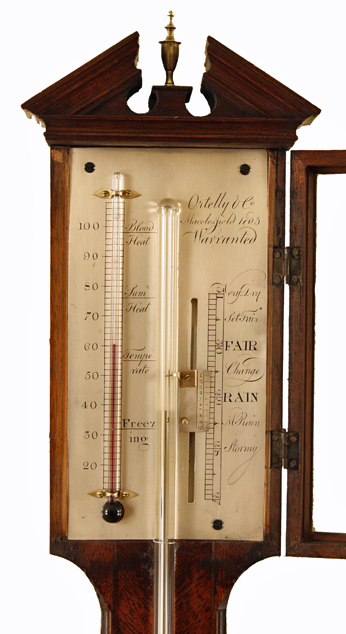
|
| The top of the tube with scale, vernier and themometer ( copyright P.A. Oxley) |
| N Ortelly & Co, Macclesfield (Macc20) |

|
| Cistern cover removed to show bulb cistern, with masking tape to protect the top. |
For the sake of simplicity I am leaving out mention of double barometers and angled
tube barometers; Banfield, Goodison and others cover the subject well. But I can’t resist a digression in order to quote
this plaintive letter on the subject of his new ‘portable’ barometer, written under the pseudonym Inquirer
which was printed in the January 1812 issue of The Belfast Monthly Magazine published by Smyth and Lyons. [Note that
‘philosophical’ meant having a good understanding of physics]. The writer has a stick barometer.
"Having lately purchased a barometer, which is partly of a new construction, I beg for the assistance of some
of your philosophical correspondents, to enable me to understand the principle on which it is formed. At bottom the mercury
appears to be contained in a leathern bag, which is enclosed in a wooden case. The bag with the mercury contained in it, is
acted on at pleasure, at its lowest extremity, by a screw and button attached to it. As I screw the button upwards the mercury
is compressed within the bag, and is, of course, forced up the tube of the barometer so as to fill it to the very top. Thus
the instrument is rendered very portable; and in so far as convenience for carriage is concerned, this construction is undoubtedly
a great improvement. Barometers of this form have, I find, been several years in use; but is has not happened that I have
attended to their construction until lately. And I am not perfectly clear that I understand it. I wish to know in what way
the weight of the atmosphere acts on the mercury, in instruments of this form. Does it act externally on the leathern bag
which contains that fluid: and if so, how does it happen that the intervention of the leather does not, in some degree, obstruct
the motion of the mercury in the tube? And is there really no such obstruction? Does the mercury in these barometers move
as easily, is it as obedient to the changes in the atmosphere, as in barometers in the ordinary form? I wish also to be informed if the bag be really of leather, and nothing else? Leather of a particular sort is, I
know, used as a strainer for mercury; and therefore I am led to think that here, there may be some other substance in addition
to the leather, within which the mercury is contained, or that the leather is prepared in some particular way. I am anxious also to know the exact height at which the mercury stands in the tube, for any given day. Supposing
that the graduation in my barometer is inaccurate; that the inches on the scale are placed too high or too low, (and I suspect
some such inaccuracy in the glass which I have purchased.) I wish to be informed, by what mode of measurement, I shall be
able to correct this mistake. The common rule to measure the from the surface of the fluid in which the barometrical tube
is plunged, is not at least of obvious application here – for I cannot determine to have from so where that surface
is. I shall be very happy to have from one of your intelligent correspondents, a full
illustration of this subject. The new construction mentioned above is clearly an improvement, where the instrument is to be
often moved and carried from place to place, but when I think of the obstruction which I apprehend to the motion of the mercury,
and the liability of the leather containing it to burst or to decay, I fear we incur a disadvantage much greater than any
advantage which can possibly accrue. The wheel barometer offers some advantages peculiar to itself – there is a very
extensive scale, by which to mark the changes of the air, and the instrument is a handsome object against a wall, but everyone
know that the construction has superior disadvantages attending it. How far this is the case with the barometer described
above, I beg to know though the medium of your excellent publication. INQUIRER"
Answer,alas, came there none, or at least not through the medium of that excellent publication.
The Wheel or
'Banjo' Barometer
Note: experts do not use the term 'banjo' barometer. If
you wish to bluff your way in this subject, always call this type of instrument a 'wheel' barometer.
The
wheel barometer to which ‘Inquirer’ alluded at the end of his letter had been developed in England
in the late 17th century by Robert Hooke, but factors such as friction led scientists to discredit it as insufficiently
accurate. Its laudable purpose was to magnify the scale which, in the stick barometer, was not easy to read without peering
closely at the instrument. It was also difficult to take very precise readings using a stick barometer, though the secondary
scale, the vernier, helped. Nonethless, some wheel barometers were produced in the early-mid 18th century, and
the survivors are simply fabulous works of art by very fine clockmakers. Below, you can see a simply splendid George
II barometer, designed and made (inv & fecit) by the famous John Hallifax of Barnsley, and there are
two links, one to another barometer in the stock of Ronald Phillips Antiques, and the other in the Royal Collection.
They really are the best you can get .And you'll need a banker's bonus or a lottery win - or just remortgage the house.
| A superb George II wheel barometer |
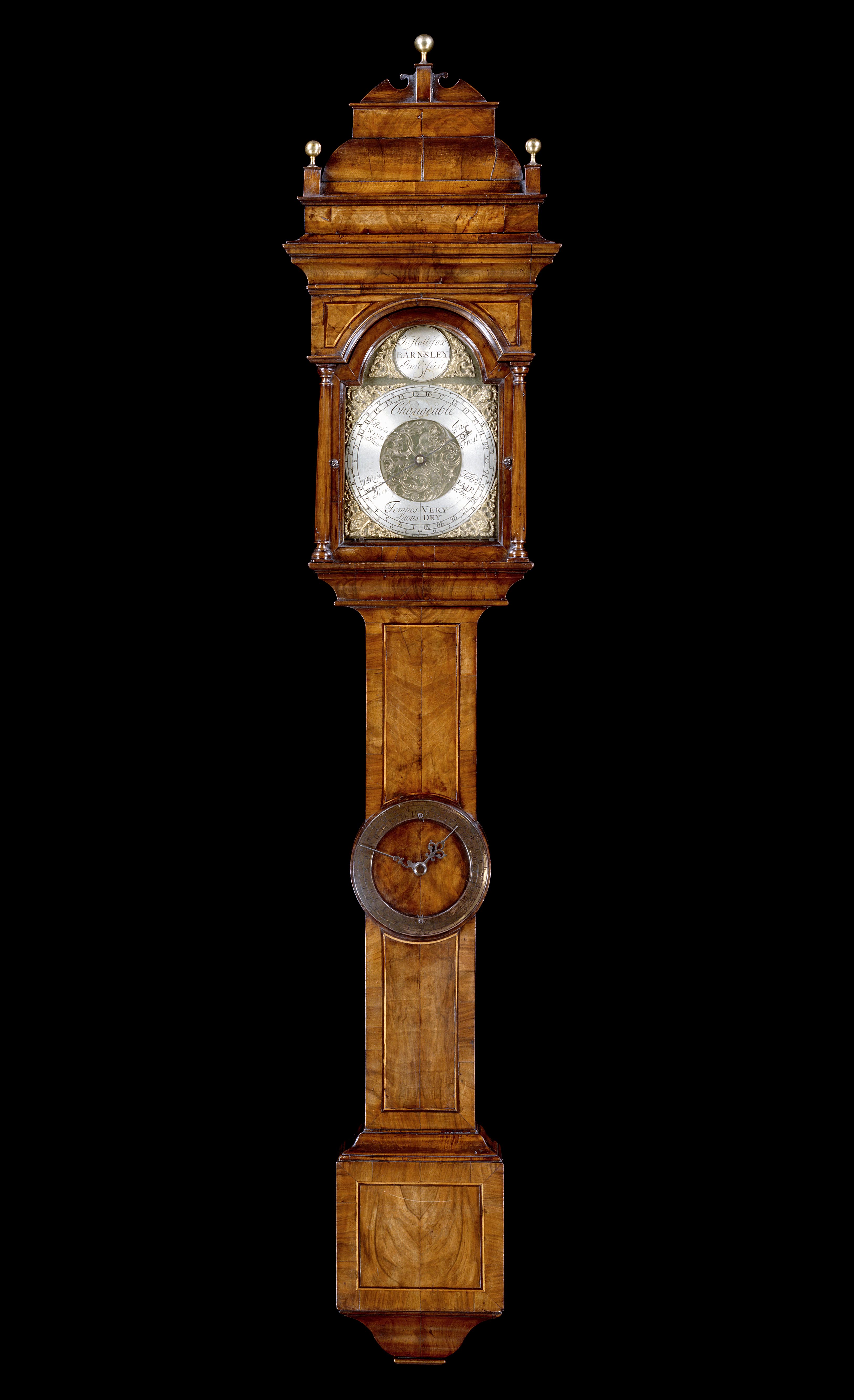
|
| Courtesy of Ronald Phillips Antiques, London |
| The dial of the Hallifax barometer |
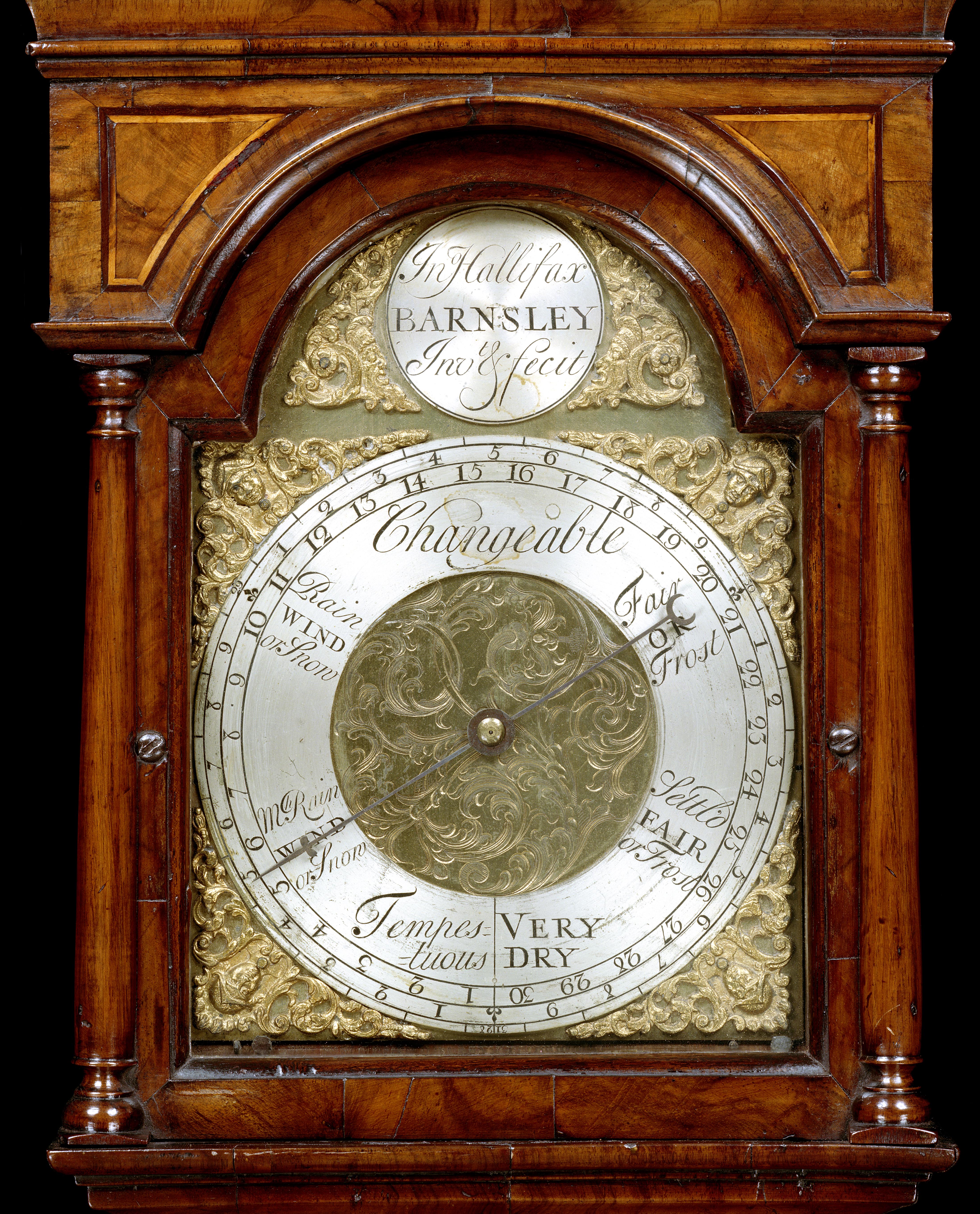
|
| courtesy of Ronald Phillips Antiques Ltd |
The following descriptive text for this barometer
is reproduced by permission of Ronald Phillips Antiques, London
A GEORGE II WALNUT
BAROMETER BY JOHN HALLIFAX OF BARNSLEY An extremely rare and important mid 18th century walnut barometer by
John Hallifax of Barnsley, of distinctive long case clock shape, having a clock hood top with brass finials and glazed arched
dial with a silvered chapter ring and brass spandrels and engraved dial centre, with typical pierced steel hands, the arch
with a silvered disc signed, ‘Jno Hallifax, Barnsley, Invt & Fecit’, flanked by turned columns above a waisted
body, cross banded and strung; having a circular central recording dial of patinated silvered brass with similar hands, terminating
in a stepped, moulded base. Only a small number of barometers by Hallifax have survived and are generally in
distinguished collections like The Victoria and Albert Museum, London, and the former collection of Percival Griffiths, Noel
Terry and Irwin Untermyer, to name but a few. All of them share the same distinctive long case clock outline, and they vary
only in minor detail or size. Note: This important barometer survives in excellent condition and has acquired
an outstanding patina. English, circa 1740
Height: 51 in; 129.5 cm Width:
10 ½ in; 26.5 cm Depth: 4 in; 10 cm
View Tompion barometer
View Corless and Barker clock/barometer
The Idiot's Guide To The Working Of The Wheel Barometer
| Workings of a wheel barometer |
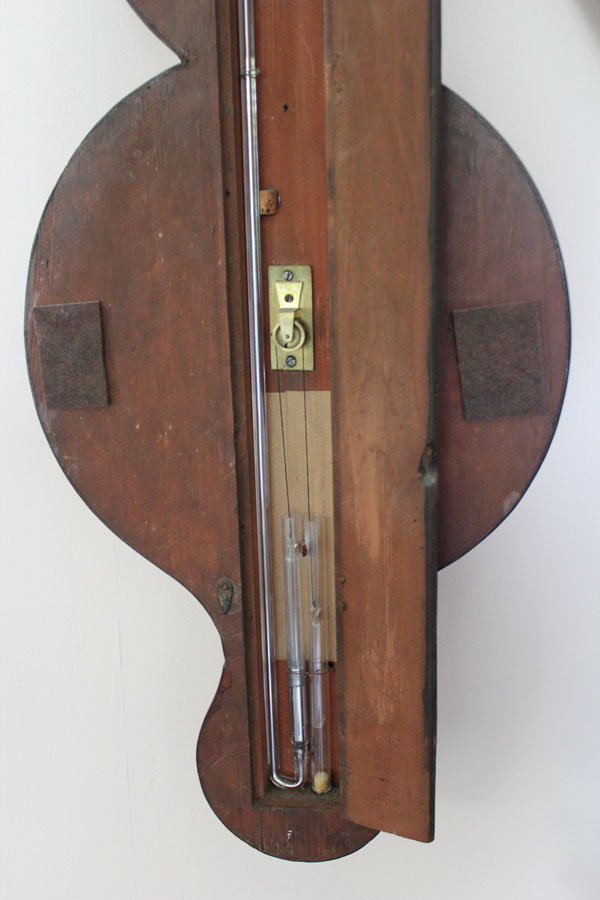
|
| The siphon tube, with rack & pulley, strings and weights. Courtesy of Horologica. |
As can be seen in the illustration above, a wheel barometer has a long siphon tube, which makes a U-turn
at the bottom, creating a short hook that acts as the 'reservoir' (this part of the tube is the 'short
limb' ). Air pressure on the surface of the mercury in the short limb is enough to support the whole column. A glass
weight rests on the surface of the mercury in the short limb of this tube. Mercury is so dense that the glass weight
really does float on it. The top of the tube, ofwhich you can't see in the image, is sealed to create a vacuum.
A fine thread, tied to the weight and traditionally made of silk, runs up to a pulley mounted on a
rack. A second thread runs from the pulley to a counterweight that hangs loose on the right hand side. However,
as in the illustration, the counterweight usually dangles inside a short length of glass tube, just to stop it swinging
around if the barometer is knocked or moved. The weights tend to be made of glass - sometimes a short length
of thermometer.
When the air pressure rises, the mercury is pushed further up into the long limb, and so the surface
level drops in the short limb. The floating weight follows it downwards, pulling on the thread which drags
the pulley anti-clockwise. The counterweight is pulled upwards. The pulley is fixed to a spindle that
runs through the barometer and on which a pointer (the indicating hand) is mounted. When the spindle turns,
so does the indicating hand. If the air pressure falls, the mercury in the long limb falls, and so rises in the
short limb, carrying the weight up with it. The thread slackens, so the counterweight comes into play, taking up the
slack and dragging the pulley clockwise.
| My 12" dial Victorian Casartelli |
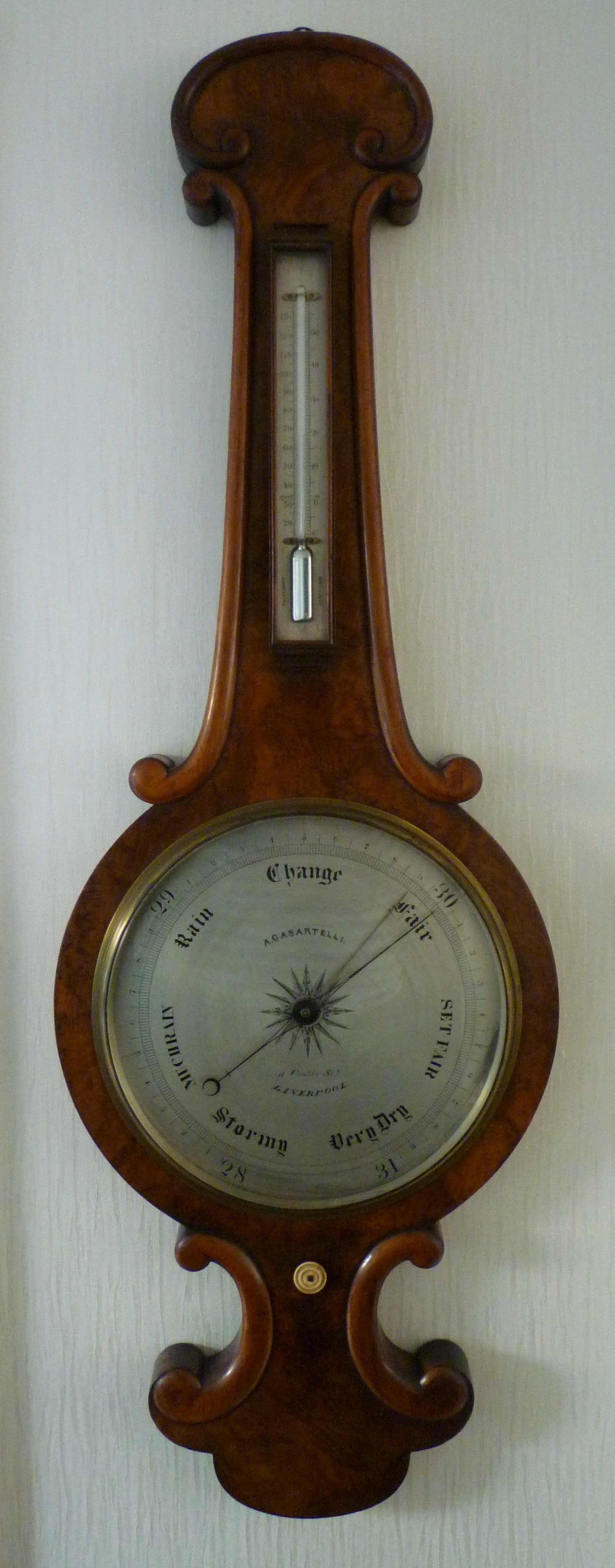
|
| Indicating hand showing current reading; set hand artificially moved to show an earlier reading. |
Viewed from the front, the indicating hand moves anti-clockwise when low pressure causes the
mercury to fall. Depending on the temperature, humidity and wind direction etc, low pressure is associated
with wind, rain and snow. If the mercury falls rapidly towards Much Rain, get the washing
in. If it heads to Stormy, batten down the hatches and don't put the cat out.
At the moment (late
March 2013) we have high pressure and bitter easterly winds here in South Cheshire. The sun is out, my barometers are holding
steady on 'FAIR', and we haven't had the awful snow that everyone else seems to have been suffering.
The washing is drying well (double pegged!). It's just viciously cold when I put it out and get it in!
The bigger the diameter of the dial, the further the arc of travel of the indicating hand. For example, if the
mercury in the tube moves by one inch, the point of the indicating hand on an eight-inch dial, is made to travel more
than six inches. So it is easy to measure to hundredths of an inch or to read the barometer from across the room.
Wheel barometers usually come with an additional hand, known as the set hand, that you turn manually if you want to
record where the indicating hand has stopped. When the air pressure changes and the indicating hand moves in response, you
can see at a glance which way and how far it has moved since the last reading. Some barometers were made with two
hands so two recordings could be made each day.
Styles of Wheel Barometer
Wheel barometers tend to be described by their pediments, diameter of dial, and
the number of components they contain.
Pediments
- Round top – exactly as it suggests:
no pediment, just a smooth rounded end to the case. Popular in the late 18th and to about 1810, it was produced
for a while longer but in rapidly diminishing numbers.
- Break-arch, broken arch, broken
pediment, triangular pediment all refer to the same thing: a moulded isosceles triangle, with the apex section removed. The
rectangular gap was often ornamented by a brass finial. The most popular pediment of the Regency period, it was supplanted
by 1830 by the scroll pediment, but it was revived in the late Victorian period and used in the 20th Century for aneroids
and reproduction Georgian mercury barometers.
| Round top |
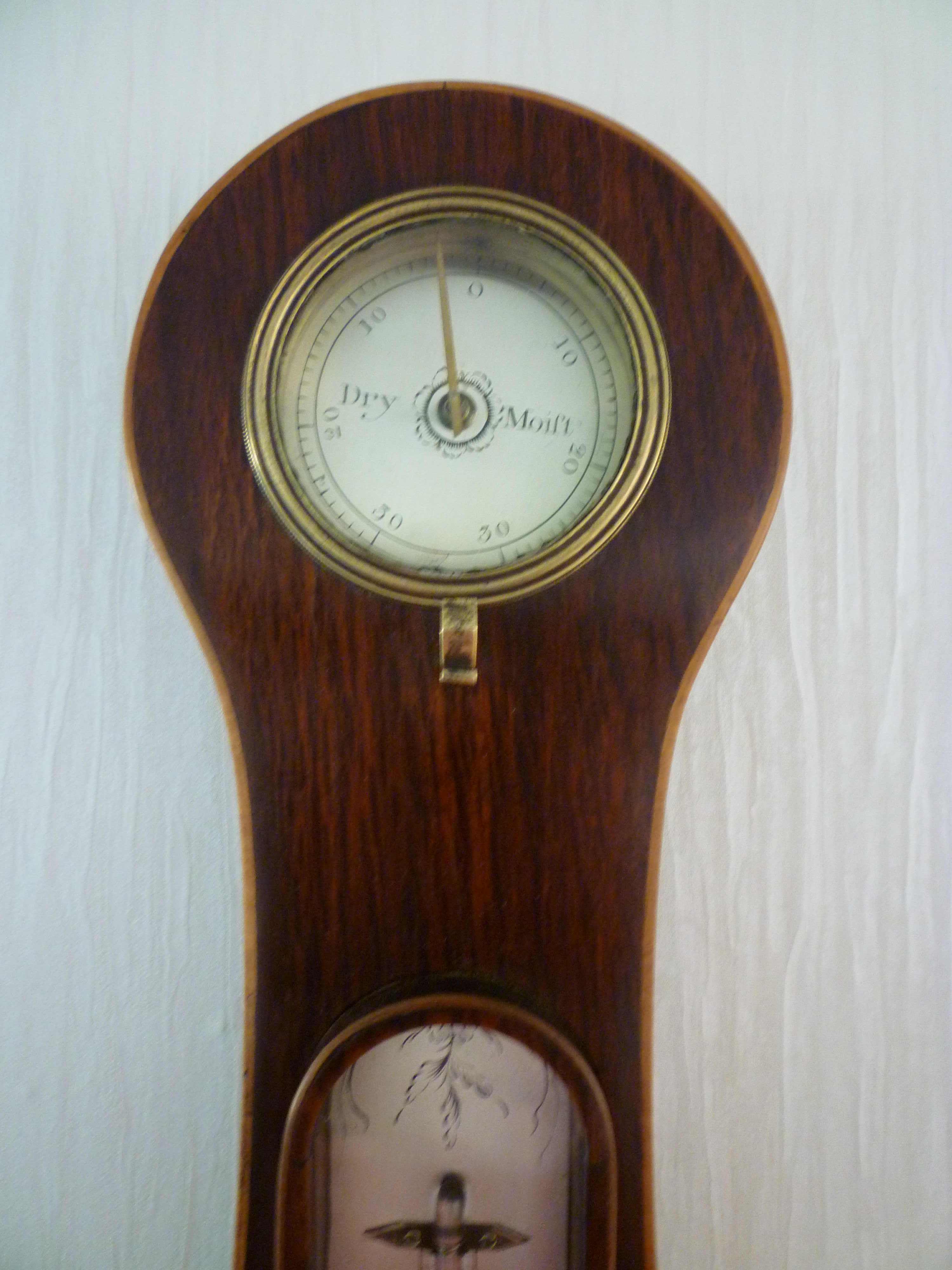
|
| Broken Pediment |
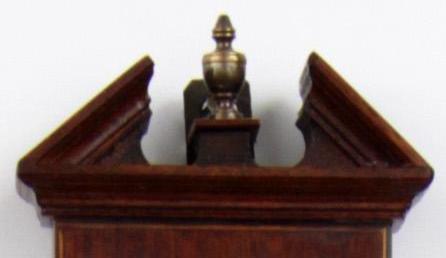
|
| Found on many barometers and always on Sheratons |
| Basic conch shell inlay of a Sheraton |
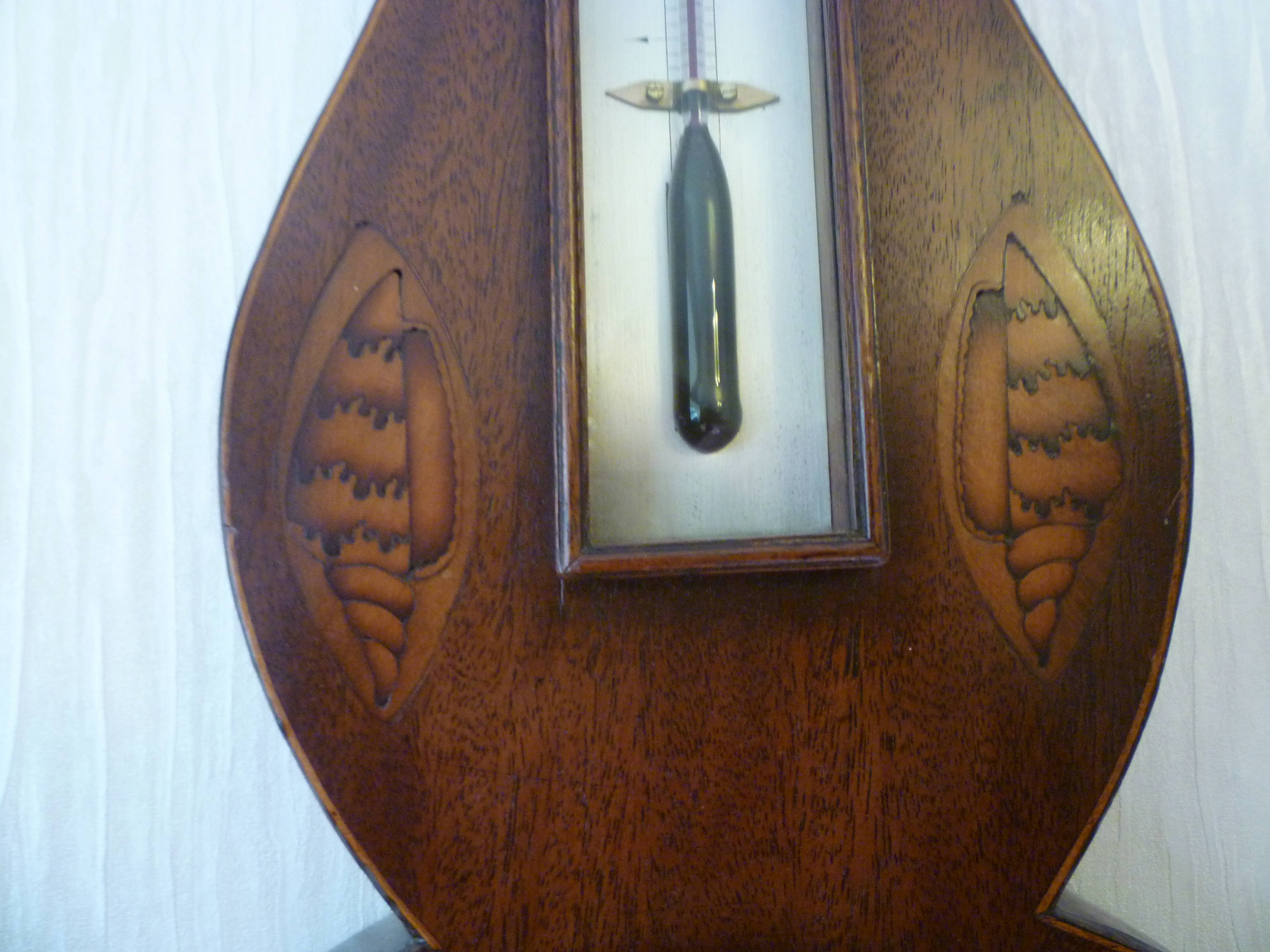
|
| Courtesy of Andrew Foott |
- Sheraton shell: a style that dominated the market from 1815-1829,
instantly recognisable through the combination of broken pediment and pair of conch shell
inlays. These inlays, called paterae are found either side of the thermometer box . A second pair of paterae, usually
despicting a stylised flower, are found below the pediment and at the very bottom. The Sheraton had only a
barometer and thermometer; the thermometer box was not detachable. Most measured 38", give or take up to an inch. Not
all makers slavishly adhered to the standard motifs; there was more variety in early types than by 1815 when it became
standardised. The Sheraton had no pretension to be anything but a decorative and domestic barometer whose owner
would have no wish to stand in the garden with the thermometer and a hygrometer in order to make predictions about the weather.
| An example of the patarae found on a Sheraton |

|
| Stylised floral Inlay using different veneers and by singeing. |
- Scroll pediment
(also called swan neck) Two inward curving ‘horns’. Seen from the end of the 18th century it became
dominant in about 1830 and went out of fashion around 1850.
| Scroll pediment |

|
| Thanks, Julie and Andrew |
During the 1850s the 'onion top' became popular
- sometimes also called the tulip top. Then in the 1860s came the scroll barometers, such as the Casartelli, illustrated in
the previous section, which didn't have pediments.
| An 1840w five-glass by Barnascone |

|
| Thanks, Julie and Andrew. |
Glasses and dials
As
each component of the barometer was behind its own glass, terms like ‘three glass’, ‘four glass’ or 'three
dial', 'four dial' etc are sometimes used for barometers with more than thermometer and barometer.
A
barometer with only one dial or glass is, quite simply, a barometer! To have only one glass, incidentally, is very rare, and
when it occurs there is usually a thermometer mounted on the main dial. Banfield speculates that this either to expose more
of the beautiful veneer or to save on the expense of a thermometer box.
‘Three glass’ usually
means the addition of any one out of a hygrometer,a spirit level or, less commonly, a fusée clock.
‘Four
glass’ is most likely to mean the addition of both a hygrometer and spirit level, but four glasses may include
a clock. A working clock is very desireable, but fusée clocks were prone to breakdown,
| Barometer by Stampa with fusee clock |

|
| courtesy of P A Oxley |
In a ‘five glass’ a fusée clock or, far more commonly, a convex mirror
provides the fifth element. The inclusion of the convex mirror is more a feature of barometers from the 1840s,
as in the Barnascone illustrated above, and many afficionados of the barometer really don't like mirrors! I have
seen a late 1830s barometer by Vitta of Stone, Stafford, in which the hole left by the removal of a (presumably broken)
clock has been masked by a mirror fitted into a hinged brass bezel. Immediately above is a rather fine 1820s barometer with
fusée clock, and it also shows the transition in style that took place during this decade. The broken pediment
has given way to the swan neck or scroll pediment, but the barometer retains the graceful lines of the previous two decades.
Dials
The Sheraton standardised the eight-inch
dial and large numbers of this type were produced. Anything below eight inches is very desirable because of the rarity
factor. Ten-inch dials are less common than eight-inch and, certainly in slender Regency barometers, can look very handsome.
Twelve and fourteen inch dials are uncommon, and usually from a later period but good ones make big statements. There are
even a few fifteen-inch barometers, originally made for very large rooms such as are found in public buildings.
Barometer Cases
The shape of the wheel barometer gave the makers
plenty of scope for using fine veneers, inlay, line inlay, stringing in various forms, crossbanding, and beautiful engraving.
It was ...a handsome looking instrument, and very suitable for a parlour or counting house. wrote Jeffery Dennis
in Ample Instructions For The Barometer And Thermometer 1818 During the early 19th century the barometer
became a lovely decorative object as well as being accurate enough for the average home or farm. Although the Victorian barometers
can be heavy and betray their mass-production and lack of artistic invention, you will find some good ones. I am unashamedly
fond of my tactile Casartelli which carries the name of a high-quality scientific instrument maker.
Veneers
The choice of veneer was, as in all interior decoration, determined by fashion. During the 17th century,
oak furniture was dominant. Late in that century and into the 18th century, walnut became the wood of choice. After 1730 imported
mahogany arrived on the scene, and one of its virtues was that, apart from looking beautiful, it was tough and had
some resistance to woodworm. The fashion for mahogany furniture lasted for more than 100 years, before the Victorians rediscovered
walnut and oak. Buyers wanted barometers that would complement their furniture, so most barometer cases made from 1780-1850 were of
pine veneered with mahogany, with flame mahogany for the best of the mahogany barometers. If you find a good example, it really
does give the impression of a roaring fire.
Some high quality barometers, however, were more exotically
veneered, with satinwood as the most popular of the uncommon woods. Pear was also used, and there are two known examples of
wheel barometers veneered in partridge wood, and one stick instrument. Occasionally walnut makes an appearance
in barometers made at a time when mahogany was the dominant veneer.
If the veneer is laid horizontally along the
side of the barometer you know you are looking at quality.
Crossbanding
The crossbanding
that appears on some of the highest quality barometers can come in various woods, but tulipwood, satinwood and kingwood
are among the preferred veneers. Barometers, like furniture, are veneered with the grain running vertically. By cutting thin
strips - say, half an inch wide, across the grain, an elegant 'frame', following the shape of the case is
created. Or, of course, the same veneer as for the case can be used: cut across the grain, it creates an interesting,
harmonious effect. You will see a lot of good quality Georgian furniture with this decoration.
Stringing
This is where the front edge of the case, where the side and front veneers meet, is finished with
a continuous line of inlaid wood, usually pale boxwood or fruitwood. It is not just decorative: it gives strength to
the edge and protects the main veneer. Stringing can be more complex, to created chequered or rope effects. This
is sometimes called 'zebra' stringing, but experts may not recognise this term. Some barometers are double strung,
with one line of ebony and another, inside it, of a paler wood. Triple stringing is not unknown. A good maker will take
the trouble to edge the thermometer case with stringing, too.
Line Inlay
A very
thin line of contrasting - usually pale - veneer on the front of the case and close to the edge or the stringing, that follows the
outline of the case and is flush with the main veneer. Two contrasting veneers can be used for this inlay, to create the
rope or chequer effect. For some very interesting articles on these subjects - and practical advice in how to do
it yourself if you have the skill, just investigate the following link:
Other Inlays
When rosewood became
the favoured veneer, case makers invoved in the creation of a high quality instrument sometimes inlaid the veneer with copious
amounts of mother-of-pearl, creating swags and trails of flowers. The rosewood, being dark, leant itself to this kind of decoration.
Brass line inlay is sometimes found, along with wire inlay . A tip: if you do have a barometer with wire inlay or any
suspicion that the mother of pearl inlay is lifting, be very careful when dusting, or you may snag the duster and
rip off some of the decoration, thus leaving you with either a very sad-looking barometer or a bill for restoration which,
if you can't find all the pieces and need to have them remade, is likely to be painful.
Styles and Decoration of
Stick Barometers
Much of what I have written about the pediments and decoration of wheel barometers
is also applicable to the stick versions. There was perhaps more variation in the pediments, though the simple rounded top,
the broken pediment and the swan neck/scroll were the most common. Cistern covers could be plain, turned or inlaid, and
the trunks and doors of instruments might be plain or edged/decorated with rope or chequered inlay. The
fashion for mahogany lasted into the middle of the 19th century and was then replaced by oak. Where the tube was visible down
the the whole length of the trunk, the maker frequently laid the veneer in herringbone fashion with the tube as the spine.
Some barometers have convex glass over the register plate - usually these are the ones where the tube is enclosed
within the trunk. Where a mahogany trunk encloses the tube, you will find (on a good instrument) a really beautiful
mahogany veneer. It's fair to say that the best examples were made by British makers. The Italian versions are, by
comparison, very standardised.
Because of the variety, I suggest you have a look at the websites of Alan Walker
and P.A. Oxley, both dealing with high quality and both with very good archives of sold barometers as well as current
stock. They deal in wheel as well as stick barometers, but their stick collections are particularly comprehensive and,
taken together, they will guide you from the late 18th up towards the end of the 19th century.
http://www.alanwalker-barometers.com/antique-barometers/stick-barometers
http://www.british-antiqueclocks.com/
WHAT'S IN A NAME?
Barometers of this period almost always bear
an engraved signature, plus an address that may include the street and number of the premises, but which is often just the
name of a town. The presence of the word ‘fecit’ (the Latin translates as he made ) should be a
guarantee that the name on the barometer is that of the maker. However, the absence of the word certainly can’t
be taken as proof to the contrary.
Edwin Banfield recorded over 3000 names from the
period 1660 to 1900. As he points out, not all were genuine makers - some were undoubtedly retailers and/or 'assemblers'
of barometers. His theory is that wholesale makers supplied provincial shops with barometers, and if the order was large enough,
the wholesaler engraved the instrument with the maker's name together with the retailer's town. It is also
possible that some provincial clients will have asked for something particular - perhaps a barometer of the same style and
quality as that purchased in London by a friend or neighbour during a trip for business or pleasure.
As the engraving of the dial had to be carried out before the copper dial was silvered and fixed to the case, that task had
to be done at an early stage, which should rule out subsequent provincial engraving. It is not impossible that one hand engraved
the scale and weather indications while another was responsible for the more decorative aspects.
However,
where barometers were fitted with spirit levels (to enable the instrument to be hung vertically for maximum accuracy) the
small silvered plate framing the level was another good place to engrave the name and address. If that engraving is crude
and simple and doesn't match the quality of the rest of the barometer, it was almost certainly done afterwards,in
the place of retail. If it is of similarly high quality, it may have been done either during manufacture or later by a good
engraver. Incidentally, one way of deciding if a barometer, whether restored or not, is 'original'
(rather than having been recently cobbled together from bits of old barometers) may be to look at the engraving
of each plate and dial to see if they have some sort of family resemblance. An expert will tell the difference,
but sometimes the instrument would have to be disassembled in order to be certain - for example, to check for
old holes in the case that don't line up with the screw holes in the existing dial.
Barometers came to be made in provincial towns, but usually with components bought in from suppliers in London or cities
of the importance of Manchester or Edinburgh.
It must be stressed that barometer making required a number of very different skills: - woodworking to carve, veneer and inlay or otherwise decorate the case and thermometer box
- glass blowing to create the main tube, thermometer and spirit level
- glassmaking to produce the flat or convex glasses covering the dials
and the thermometer.
- metalworking to cast the main bezel
and make the small bezels, dials and register plates etc
- Bone
or ivory turning to make the discs that were used as knobs to control the setting hand or as decorative rosettes on the
ends of some scroll pediments.
- French polishing
It’s very hard to imagine one person having all these
skills to a high standard, A family business might span the required trades, and maybe different families pooled their talents.
Soon, components came be to contracted out to specialists within or even outside the Italian community in and around
Holborn. Nobody can be sure exactly what percentage of a barometer is attributable to the individual whose name is engraved
on it. Industrialisation later drove the trade into mass production and standardisation.
Some of the Italians are listed as carvers, some as glass makers, some as ‘scientific and philosophical
instrument makers’ . That last category would undoubtedly have made the tubes and the thermometers for themselves and
others.
Whether many Italian 'makers' who also sold a variety of wares
(such as looking glasses, artificial flowers and picture frames) ever made the barometer that carries their name is
where the doubt lies. Maybe they bought them in to add variety to their stock – conversely, they may have made the barometers
and bought in the other stock to increase the viability of their business.
None of this should be surprising to us. Nobody seriously imagines (one hopes!) that Mr J. Sainsbury
slaved over a hot pan of boiling fruit and sugar, and then turned his hand to glass-blowing or mounding, to make the
jar of strawberry jam that carries the Sainsbury label. Monsieur Pierre Cardin did not personally hand-weave, cut out and
sew the T-shirt that boasts his logo. A local craft pottery, for example, may well stock some mass-produced fridge magnets
and fudge that tempt tourists to spend something in the shop even if they can’t afford the potter's
own hand-made stock.
In a way,
it hardly matters at this first half of the 19th century. However many hands made the barometer, it was made by hand.
Every one is unique, whether through engraving, inlay, style of case,a few millimetres of length, or, in the case of
this1820s J. Pastorelli, an actual error! Engravers frequently seemed to take pride in their work and dials can be very
finely and elaborately engraved, but if you look carefully at the engraving of the scale around the main dial on
the image below you will discover a serious error. You could say it lends the instrument additional charm! On the other hand,
it makes it pretty useless for accurately recording the air pressure. Incidentally, this photograph was taken before
restoration.
| J Pastorelli, Sheraton |
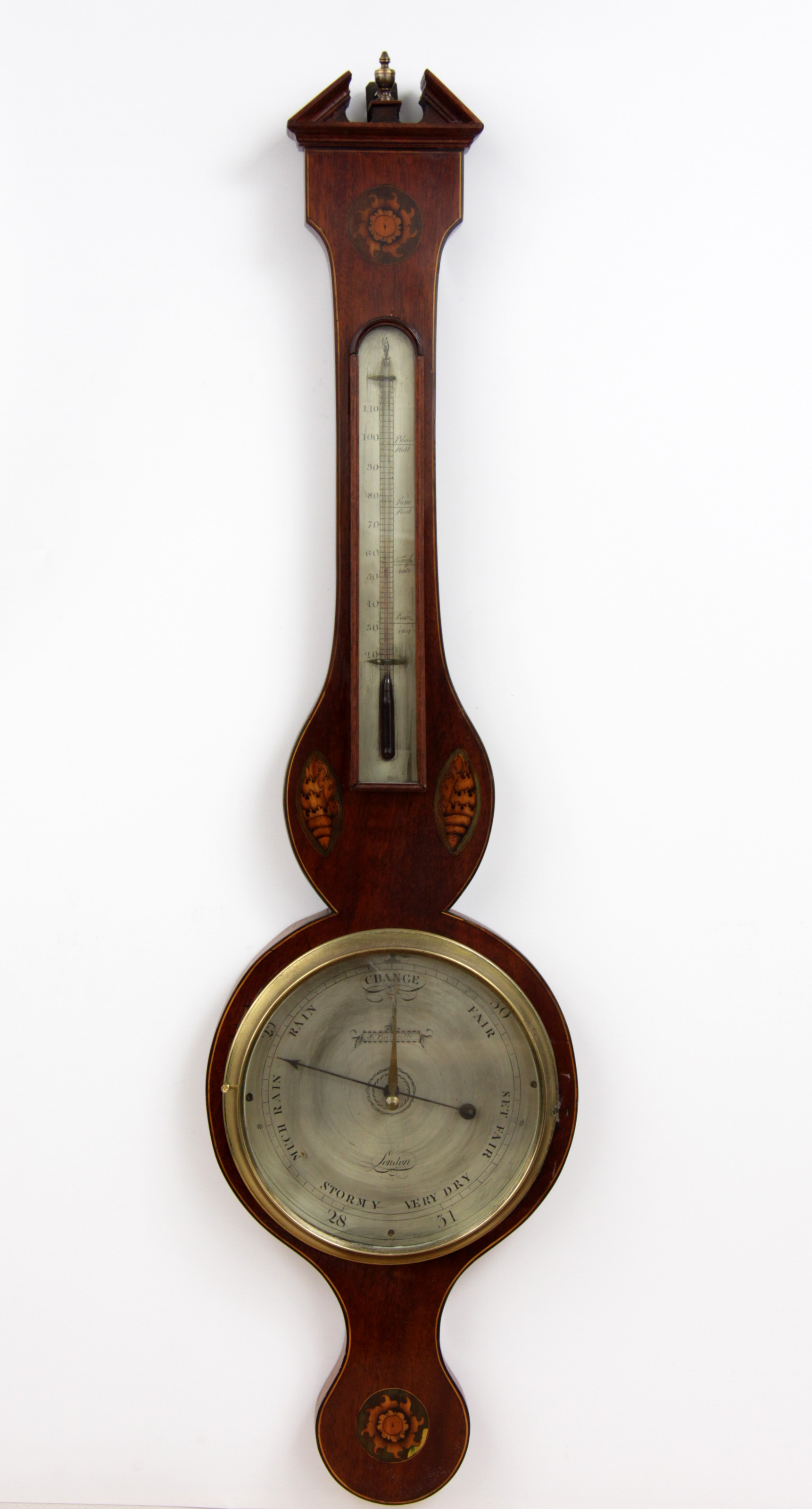
|
| count the divisions on the scale! |
Next page: The Elusive Ortellis of Macclesfield 1805-1820
Go To: The slightly less elusive Ortellis of London, Buckingham etc.
Go to: The Ortellis from 1825
Go to: Buying, Restoring and Further Reading
Top of Page
Go back to Antique Barometers - Introduction
Go back to Homepage
|

